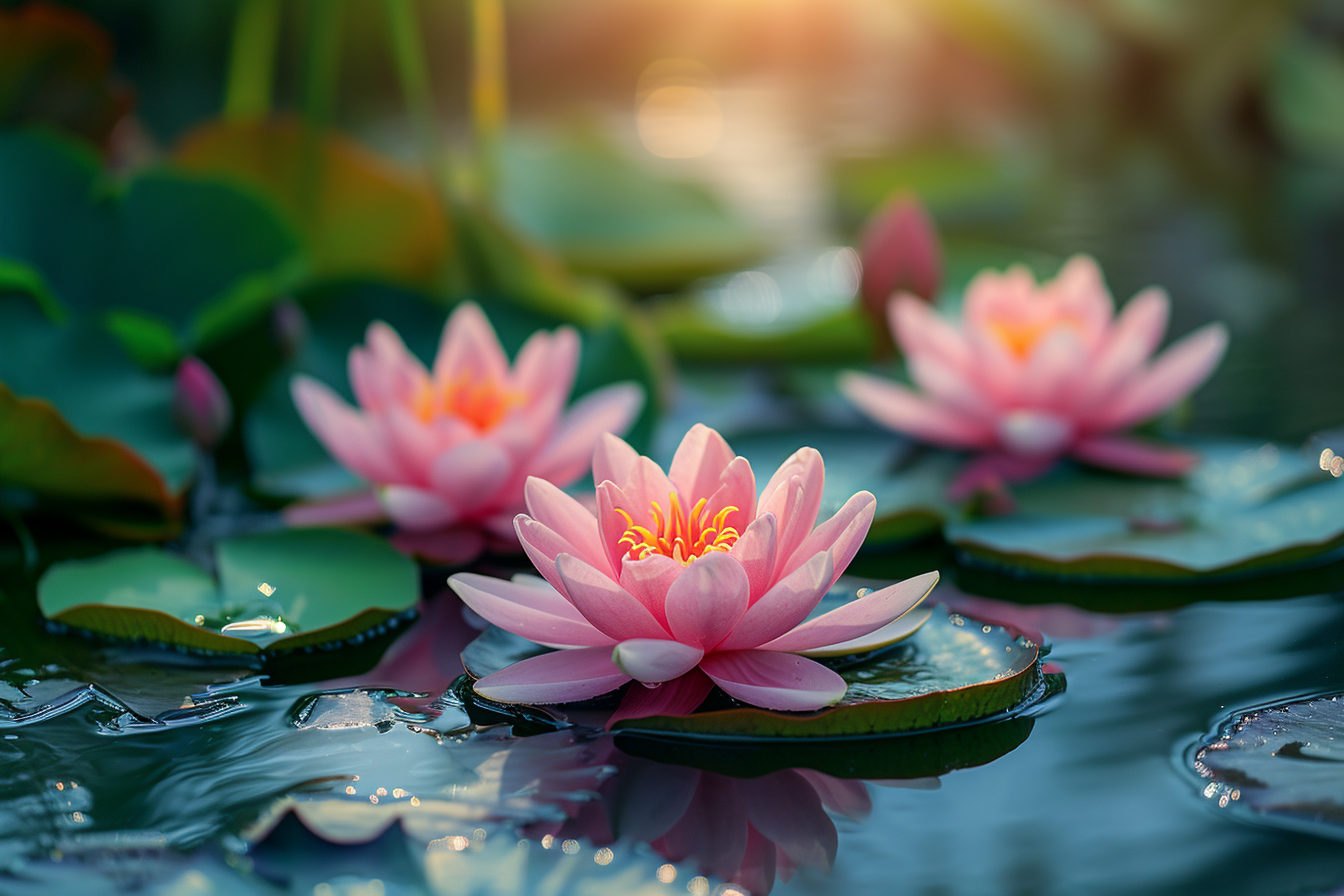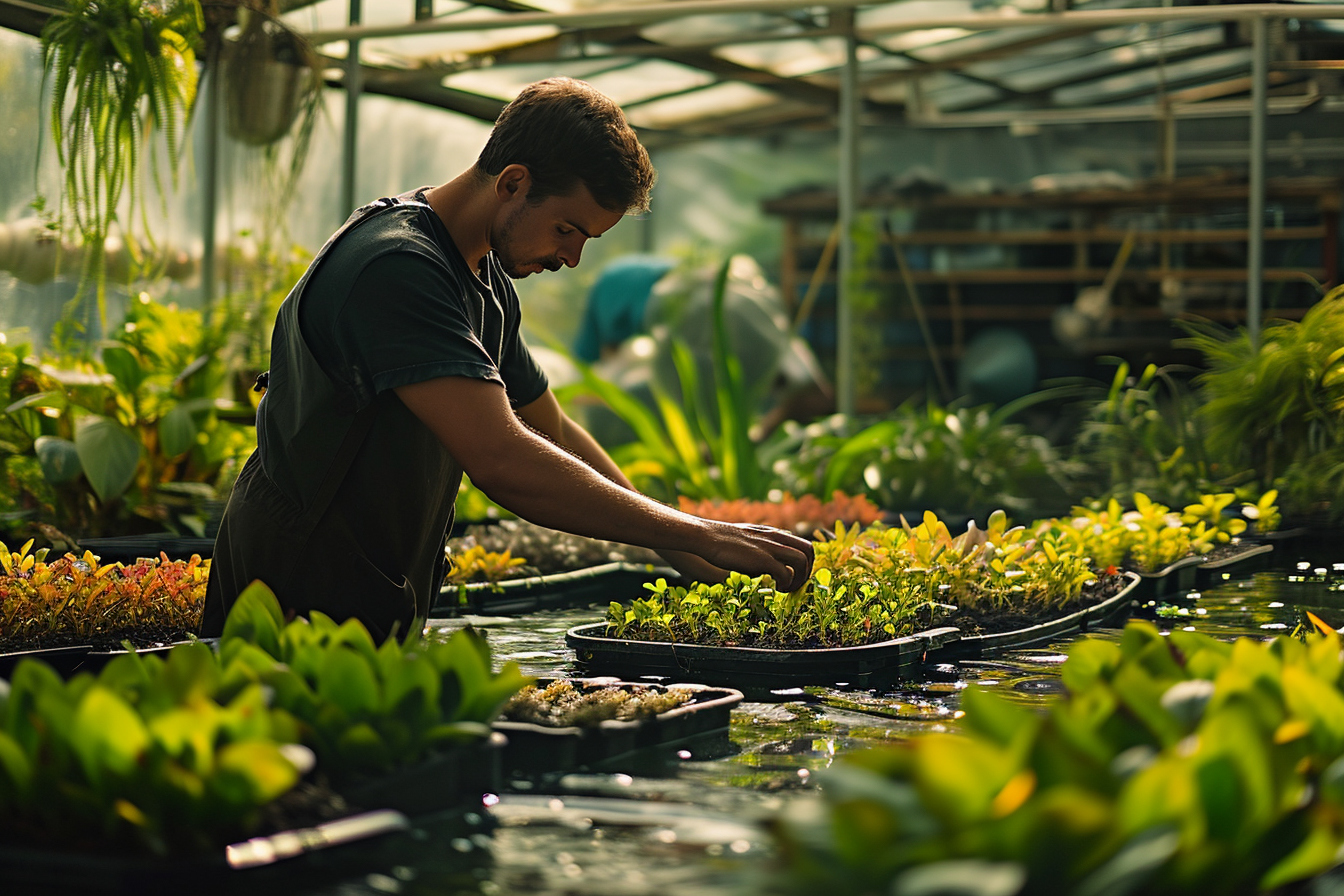The allure of a tranquil aquatic garden is undeniable. These vibrant ecosystems not only enhance the beauty of any space but also foster a meditative and serene environment. Mastering the art of creating such gardens requires an understanding of the intricate balance between the aquatic plants and their environment. Delving into the world of aquatic gardening opens up a panorama of exotic plant varieties, each with unique requirements and contributions to the aquatic tableau.
Fundamentals of aquatic gardening
Understanding water chemistry
Successful aquatic gardening begins with a comprehension of water chemistry. The pH level, which measures acidity or alkalinity, directly influences plant growth. Most aquatic plants thrive in a neutral pH range (6.5 to 7.5). Testing kits are essential tools for monitoring water chemistry regularly. Additionally, water hardness and nutrient levels play a critical role in plant health. A balance of essential nutrients such as nitrogen, phosphorus, and potassium supports lush growth while warding off algae.
Controlling Algae Growth
Algae is a natural part of any aquatic ecosystem yet can quickly overpower a garden if left unchecked. Adequate plant coverage that competes with algae for nutrients, proper filtration, and limiting sunlight exposure can help manage algae growth. Strategically positioning plants and utilizing floating species create shade, further reducing the risk of algae proliferation.
The role of filtration systems
Robust filtration systems are the cornerstone of clear and healthy aquatic gardens. Mechanical and biological filters work in tandem to clean the water and break down harmful waste products. The mechanical filter catches debris, whereas the biological filter houses beneficial bacteria that convert ammonia and nitrites into nitrates, which aquatic plants can utilize.
Designing your aquatic garden

Planning Layout and Depth
Crafting an aquatic plant garden is akin to painting a landscape where depth and variety create visual appeal. Shallow zones favor marginal plants, while deeper parts are ideal for submerged species. The layout should factor in viewing angles and how the garden complements the surrounding area, ensuring a cohesive design.
Choosing the right plants
Selecting Plants Based on Growth Patterns
Aquatic plants are categorized based on their growth patterns:
- Floating Plants: These unanchored plants, like water lettuce and duckweed, provide shade and help control algae.
- Submerged Plants: Often referred to as oxygenators, they grow completely underwater, contributing to the water’s oxygenation and clarity. Examples include anacharis and hornwort.
- Marginal Plants: These plants grow on the water’s edge or in shallow water. Common choices are cattails and pickerel rush.
- Deep-Water Plants: Water lilies and lotuses are the stars of this group, gracing the depths with their flowers.
Considering Plant Hardiness Zones
Being mindful of plant hardiness zones ensures that species selected for the garden can survive the local climate. Tropical plants, while enchanting, may require additional heating or should be treated as annuals in colder regions.
Aquatic plant care and maintenance
Regular Pruning and Trimming
To maintain aesthetics and plant health, regular pruning and trimming are necessary. It entails removing dead foliage, controlling plant size, and preventing invasive species from dominating the space.
Overwintering Strategies
For colder climates, overwintering strategies are critical for perennial aquatic plants. Hardy plants can typically remain in the garden if the water does not freeze to their depth. Tropical species may require moving indoors or employing water heaters.
Fertilization Techniques
Fertilization bolsters plant growth but must be administered carefully to prevent nutrient overload, which could stimulate algae bloom. Specialized aquatic plant fertilizers are recommended, and they are typically added every few weeks during the growing season.
Cultural techniques for optimal growth
Sunlight Exposure and Shading
Aquatic plants need ample sunlight for photosynthesis, usually around six hours of direct sunlight per day. However, shading is equally important to mitigate algae growth and to reduce evaporation. This can be achieved with the use of strategically placed floating plants or artificial shading methods.
Temperature Considerations
Temperature fluctuations influence aquatic plant health. Different species have varying tolerances, but most flourish between 65°F and 75°F. Water temperature should be monitored and regulated, particularly for ponds that are shallow or in full sunlight.
Problem-Solving in aquatic gardens
Tackling common pests and diseases
Aquatic gardens can attract pests such as snails or suffer from diseases like root rot. Manual removal, the introduction of predators, or use of organic treatments can mitigate these issues. It’s vital to address problems early to prevent them from spreading.
Managing Plant Crowding
As aquatic plants grow, they can crowd each other, leading to competition for resources. Periodic thinning ensures each specimen has enough space and nutrients to thrive, thereby preserving the garden’s balance.
Integrating wildlife into the aquatic garden
Creating a haven for beneficial species
Attracting Pollinators and Predatory Insects
Floating and marginal plants not only add beauty but also serve as landing platforms for pollinators. These beneficial insects aid in plant propagation, while predatory insects help control pest populations.
Supporting Amphibians and Fish
Incorporation of amphibians such as frogs and toads, as well as fish, can bring the garden to life and contribute to the ecosystem’s balance. Selection of non-aggressive fish that coexist with plants is crucial for a harmonious aquatic garden.
Advanced techniques for aquatic plant enthusiasts

Hybridization and Propagation
Experimenting with hybridization and propagation can lead to unique plant varieties and personalize the aquatic garden. Techniques such as dividing rhizomes and collecting seeds can propagate favored plants, creating a continuity of the garden’s beauty.
Utilizing high-tech equipment
Implementing Automated Watering Systems
To optimize care, automated watering systems and smart sensors can monitor and adjust feeding schedules, pH, and temperature, keeping the aquatic garden flourishing with minimal manual intervention.
Innovative Lighting Solutions
LED lights with spectral tuning can enhance plant growth and allow for extending daylight hours, especially beneficial in regions with limited natural sunlight. These lighting systems also provide opportunities to highlight the garden for nighttime viewing.
Nurturing the spiritual and aesthetic aspects
Incorporating Aesthetic Elements for Visual Depth
Strategically placed rocks, driftwood, and features like waterfalls or fountains contribute to the overall aesthetic while simultaneously oxygenating the water.
Fostering a Space for Mindfulness and Reflection
Aquatic gardens are not just about the plants but also about creating a tranquil space for rest and reflection. The harmonious interplay of flora, water, and fauna encourages a sense of peace and connection to nature.
Final thoughts on mastering water wonders
Gardening enthusiasts who embark on the journey of creating an aquatic plant garden are rewarded with a tranquil oasis that brings a sense of wonder to their surroundings. Every aspect, from the selection of plants to the intricate care routines, contributes to the vibrant tapestry of life beneath the water’s surface. Engaging with this living art form offers an ongoing learning experience and an opportunity to connect with nature’s rhythms.
The adventure of aquatic gardening is a continuous process of discovery and mastery. As techniques improve and knowledge deepens, the aquatic garden transforms, mirroring the growth of its cultivator. The artistry involved in shaping these water wonders beckons constant exploration, and the path to creating an exotic aquatic plant garden is as enriching as the gardens themselves.